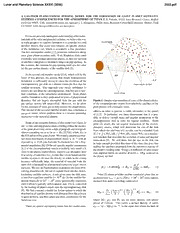
NASA Technical Reports Server (NTRS) 20050166876: A Gas-Poor Planetesimal Feeding Model for the Formation of Giant Planet Satellite Systems: Consequences for the Atmosphere of Titan PDF
Preview NASA Technical Reports Server (NTRS) 20050166876: A Gas-Poor Planetesimal Feeding Model for the Formation of Giant Planet Satellite Systems: Consequences for the Atmosphere of Titan
Lunar and Planetary Science XXXVI (2005) 2053.pdf A GAS-POOR PLANETESIMAL FEEDING MODEL FOR THE FORMATION OF GIANT PLANET SATELLITE SYSTEMS:CONSEQUENCESFORTHEATMOSPHEREOFTITAN.P.R.Estrada,NASAAmesResearchCenter,Moffett FieldCA94035,USA,([email protected]), I.Mosqueira,NASAAmesResearchCenter/SETIInstitute,MoffettField CA94035,USA([email protected]). tmloeTootfoehovfnfhneirecsmsetmtnatehssGIhfiattebntcuegekarieelavisetttlgrnahueltielantaperneymoesbrtrnsfiosoupospodet(uguladhl,acermarsreetnonefnpshldanesscseretcsomdeetphteclsilhraabe(renaodcai(cid:0)rnenntuectsardet)egnraln,ramteymthissdveowti)ioiotleqnnpoyluhdimiualndlfietaoditceoblneiefehomre[sefnqvt1ocgrthdiauea,ersamt2esarrmnep.-y]testlor-eayspaeonIdptsuftlopeiheheeionbsaeslinlandntolnun[stuieg,i3cliteilaanreseea,sKsle4gs,tldtt,ee]yoaosoii,wspnntsonswaclkdteeeuotsgihhrlf[bpnrnafir2iabeaegspecs]tulniceh-.eoidltioetehffiedwspvpnetrciaeehtsichtrlnsketecwlaeuhishtmbndreouvovmege-reawiie.bcctltvuneauahueIasrydnyee-slt. 23232323232323232323232323234343434343434343434343434343G23232323232323232323232323234343434343434343434343434343ian23232323232323232323232323234343434343434343434343434343t 23232323232323232323232323234343434343434343434343434343Pl23232323232323232323232323234343434343434343434343434343~an 23232323232323232323232323234343434343434343434343434343kemt2222222222222244444444444444 sizº3º3(cid:236)3(cid:236)3eºº(cid:236)(cid:236)d ØØŒŒobject(cid:237)(cid:237)(cid:238)(cid:238)sªª(cid:228)(cid:228) ••‚‚~„3„3”3”33(cid:239)3(cid:239)3(cid:239)3(cid:239)3(cid:240)3(cid:240)3(cid:240)3(cid:240)30„„””(cid:239)(cid:239)(cid:239)(cid:239)(cid:240)(cid:240)(cid:240)(cid:240) R(cid:229)(cid:229)(cid:230)(cid:230)}}~~(cid:147)(cid:147)(cid:148)(cid:148) 5566 (cid:143)(cid:143)(cid:144)(cid:144)»3»3;;<<(cid:127)(cid:127)(cid:128)(cid:128)»»……778899::(cid:129)(cid:129)(cid:130)(cid:130) (cid:141)(cid:141)(cid:142)(cid:142)==>>(cid:145)(cid:145)(cid:146)(cid:146)A3A3B3B3ˇ3ˇ3—3—3Q3Q3(cid:139)3(cid:139)3(cid:181)(cid:181)¶¶˝˝˛˛AABBˇˇ——(cid:231)3(cid:231)3(cid:231)3Ł3Ł3Ł3QQRR(cid:139)(cid:139)(cid:140)(cid:140)E3E3F3F3(cid:209)(cid:209)(cid:210)(cid:210)ÆÆ(cid:226)(cid:226)(cid:231)(cid:231)(cid:231)ŁŁŁEEFF??@@(cid:131)(cid:131)(cid:132)(cid:132)G3G3H3H3(cid:149)3(cid:149)3(cid:150)3(cid:150)3‰‰(cid:190)(cid:190)``´´ GGHH(cid:149)(cid:149)(cid:150)(cid:150)CCDD££⁄⁄˙˙¨¨(cid:137)3(cid:137)3(cid:138)3(cid:138)3¿¿(cid:192)(cid:192)]]^^(cid:137)(cid:137)(cid:138)(cid:138)¸¸(cid:204)(cid:204)OOPPIIJJ¡¡¢¢ M3M3N3N3(cid:135)3(cid:135)3(cid:136)3(cid:136)3––††(cid:223)(cid:223)(cid:224)(cid:224) MMNN(cid:135)(cid:135)(cid:136)(cid:136)[[\\(cid:151)(cid:151)(cid:152)(cid:152)¥¥ƒƒSSTT(cid:157)(cid:157)(cid:158)(cid:158)KKLL(cid:155)3(cid:155)3'3'3‡3‡3flfl(cid:176)(cid:176)(cid:201)(cid:201)˚˚Y3Y3Z3Z3«3«3‹3‹3(cid:211)3(cid:211)3(cid:212)3(cid:212)3(cid:213)3(cid:213)3(cid:214)3(cid:214)3(cid:155)(cid:155)(cid:156)(cid:156)''““‡‡··YYZZ««‹‹(cid:211)(cid:211)(cid:212)(cid:212)(cid:213)(cid:213)(cid:214)(cid:214)§3§3UUVV§§¤¤__‘‘(cid:215)(cid:215)(cid:216)(cid:216)(cid:153)(cid:153)(cid:154)(cid:154)(cid:221)(cid:221)(cid:222)(cid:222)(cid:159)(cid:159)(cid:160)(cid:160)a3a3b3b3(cid:133)3(cid:133)3(cid:134)3(cid:134)3WWXXaabb(cid:133)(cid:133)(cid:134)(cid:134)››fifiˆˆ˜˜ (cid:219)(cid:219)(cid:220)(cid:220)(cid:217)(cid:217)(cid:218)(cid:218)uuvvccdd mmnnw3w3gghh¯¯˘˘ wwxxeeff iijjssttooppkkll{{||y3y3z3z3qqrryyzz æææææ(cid:242)(cid:242)(cid:242)(cid:242)(cid:242) focus of this abstract, we assume that steady hydrodynamic J turbulenceissufficientlystrongtocausetheevolutionofthe ~ RH /2 circumplanetarygasdiskonashortertimescalethanthatfor Possible irregular satellites? satellite accretion. This approach uses steady turbulence to removethegasfromthecircumplanetarydiskbutnottofine- tuneconditionsofthesubnebularenvironment. Giantplanet Satellite embryos satelliteformationisthenunderstoodintermsofplanetesimal dynamics that are largely uncoupled from the gas with the Figure1:Graphicrepresentationofsomeofthecharacteristics gas surface density left unspecified. However, we do allow ofthecircumplanetaryswarmfromwhichthesatellitesofthe forthepresenceofsomegastohelpexplaintheobservations. giantplanetswilleventuallyform. Thissecondofthetwo-endmembermodelsthusconstitutesa address inorder to provide a viable alternativeto the model gas-poormodel,wheresatellitesforminamannersomewhat of [1,2]. In particular, one must demonstrate that it is pos- analogoustotheterrestrialplanets. sible to deliver enough mass and angular momentum to the circumplanetary disk to form the regular satellites. From Someoftheplausiblefeaturesofthismodel(seeFigure1) point (2) above, the net angular momentum of the circum- are:(1)late-arrivingplanetesimalscollidingwithinthevicinity planetary swarm, which will determine the size of the disk ofthegiantplanetmaycreateadisko(cid:2)(cid:4)f(cid:3)(cid:6)pr(cid:5)(cid:8)o(cid:7)gradeandretro(cid:2)(cid:9)gr(cid:3)ade (cid:1) f(cid:31)!r o"m$ whic h"%ıthe "sate l"li(cid:5)tesıwil l" acc r"ete,canıbe e" stimatedfrom objectsextendingouttoasfaras [5,6],where is (cid:25)(cid:244)(cid:243) (cid:11) (cid:15)(cid:247)(cid:246) (cid:243) (cid:11) (cid:15)(cid:247)(cid:246) (cid:11) (cid:15) where isadistribu- theHillradiusofthegiantplanet. Weinitiallyassumeapower- (cid:10)(cid:12)(cid:11)(cid:14)(cid:13)(cid:16)(cid:15)(cid:18)(cid:17)(cid:19)(cid:13)(cid:21)(cid:20)(cid:23)(cid:22) tionfunctionthatdescribestheaccretionofmassandangular lawmassdistribu(cid:5)(cid:30)ti(cid:29)onofplanetesimals withan (cid:24)(cid:26)(cid:25)(cid:28)(cid:27)(cid:8)(cid:27) momentum [9]. We will show that the size of the disk can exponent (seefootnote2)characteristicforafrag- belargeenoughprovidedthatmostofthemassthatgoesinto m(cid:31)! #e"%n$ tedpopulation[6];(2)thenetspecificangularmomentum makingthesatellitesoriginatedfromtheoutermostregionsof ofthecircumplanetaryswarmisinitiallyverysmall;(3) theplanet’sfeedingzone. Usingadistributio(cid:7)(cid:30)n(cid:2)(cid:9)o(cid:3) fsemi-major closetotheplanet,hypervelocityimpactscanultimatelylead (cid:1) axesdepletedinsideanannulusofwidth centeredon toavarietyofoutcomes(i.e.,Jovian-likeversusSaturnian-like theplanet,wefind satellitesystems);(4)oncethedensityofsolidsintheswarm becomes sufficientlylarge, the removal ofmaterialfrom the (cid:31)! (" $ outerdiskisbalancedbyplanetesimalcapturebylargerswarm (cid:31)! " $ (cid:29)(cid:8)(cid:252)(cid:253)(cid:2) (cid:3)(cid:255)(cid:254) (cid:2) ) (cid:2) particles. Werelyonfragmentationtodecreasethesizesofin- (cid:1)ł’œøß ) (cid:1)(cid:0) (cid:25) (cid:2)(cid:4)(cid:3)(cid:6)(cid:5) (cid:1)(cid:244)ß(cid:30)’ (cid:5) ø (1) comingplanetesimals,butnottocapturethemintotheswarm. Excludingsatelliteembryos,atanygiventimethediskmass Point(5)aboveprovides(cid:5)(cid:30)(cid:252)anotherconstraintgiventhatan islessthanagalileansatellite((cid:1)&(cid:27)(’*),+ g);(5)thesatellitefor- accretiontime (cid:1) (cid:20)(cid:19) (cid:0) (cid:1) (cid:27)-’ . 0 (cid:27)(’ + yearsimplies (cid:27)-’/.(cid:6)01(cid:27)-’ + (cid:7)(cid:9)(cid:8)(cid:9)(cid:10)(cid:11)(cid:10) (cid:13)(cid:12)(cid:15)(cid:14)(cid:17)(cid:16)(cid:18)(cid:14) mationtimescaleof years(presumablyconsistent aninnerdiskmass(excludingembryos)of with Callisto’spartiallydifferentiated state[7])is controlled bythefeedingofplanetesimalsontothecircumplanetarydisk [d8is].triWbuetifiornstocfosnastterlulictteadmenosditeylwfoirthJodvisiatannscyesftreomminthwehpircimhathrye (cid:3) (cid:0) (cid:1) (cid:21) (cid:14) (cid:23)(cid:25)(cid:24) (cid:12)ß (cid:14) )(cid:29)(cid:28)(cid:31)(cid:30)(cid:4) (cid:3) !#(cid:14) "(cid:4)$ (cid:28)%(cid:30) (cid:2) (cid:0)’) &(cid:4)& (cid:3) (cid:14)(cid:20)( (2) (cid:7)(cid:9)(cid:8)(cid:9)(cid:10)(cid:22)(cid:10) (cid:27)(cid:26) isquiteuniform,andthenadaptanddrawconclusionsforthe Saturniancase. where (cid:3) , , and (cid:21) are the mass, density, and orbital (cid:14) (cid:12)(cid:15)(cid:14) (cid:14) period of Callisto. This yields a surface density of solids Thereareseveraloutstandingissuesthatthismodelmust (cid:19) (cid:0) (cid:1) (cid:27)-’(cid:4)01(cid:27)(’(cid:8)’ gcm(cid:20) ) . Intheouterdiskwherethebulkof Lunar and Planetary Science XXXVI (2005) 2053.pdf materialiscaptured,amass(cid:3) (cid:0) mustbedeliveredtotheinner volatile elements such as Ar that condense at much lower diskandalso(cid:5) re" plenishedtotheswarmina“collisionalcycle” temperatures & ß(cid:30)’ K.Itisimportanttonote,however,thatto (cid:7) (cid:10)(cid:1)(cid:0)(cid:3)(cid:2)(cid:4)(cid:2) (cid:1) "(cid:21) ) (cid:7) ) . This provides a constraint on the optical formtheclathrateofAr,themod(cid:29)elof[16]requiresaverylow depth1 (cid:7) ) intheouterdisk solarnebulatemperature$ (cid:1) ß K.Sinceevenpassivedisk " ß (cid:19) (cid:21) (cid:3)(cid:8)(cid:7) modelsofTTauristars[17,18]maybetoowarmatthelocation (cid:7) ) (cid:25) ! ) (cid:1) ) (cid:3) (cid:0) (cid:1) (cid:9)(cid:11)(cid:10) (cid:27)-’ (cid:20) (cid:12) ( (3) ofJupiterfortheincorporationofArintoplanetesimals,itis (cid:12)(cid:6)(cid:5)(cid:31)(cid:16) ) (cid:7) (cid:8)(cid:9)(cid:10)(cid:11)(cid:10) difficulttoexplainwhythereisanyenrichmentofArineither wherequantitieswithsubscript“2”refertotheouterdisk, is model. (cid:12)(cid:13)(cid:5) thesatellitesimaldensity,(cid:16) ) isthecutoffsizeofthedistribution However, it cannot be assumed that material condenses ofswarmpariticles,and (cid:3) (cid:7) isthefinalmassofthesystem. from a cooling protoplanetary nebula at its solar abundance The surface density needed in the outer disk is (cid:19) ) (cid:1)(cid:255)(cid:27)-’(cid:30)’ g and remains in place. Significant radial migration of solids (cid:20) ) cm . Hence,forJupiter,aconstantsurfacedensity(solids) willtakeplace. Indeedthereiscompellingobservationalev- diskmaysatisfythesystemconstraints. (cid:1) (cid:27)-’(cid:30)’ idence that disks around T Tauri stars can be AU or Giventheseassumptions,wecananalyticallyestimatethe more [19,20]. Furthermore, some gas disks around young amountofmassdepositionperunittimeintothecircumplan- stars show flat density distributions [21,22], implying that a etaryswarm (cid:3) (cid:14) usingamassinflowrate andprobabilityof (cid:15) significantfractionofthemassofthediskislocatedatlarge capture [5] (cid:16) distances from the star. Since an ice grain may retain its (cid:1) (cid:27)(’ amorphousstateforthelifetimeofthenebula( years) &% (cid:3) (cid:14) (cid:25) (cid:7) (cid:24)(cid:18)(cid:17) (cid:11) (cid:2) (cid:15) (cid:11) (cid:2) (cid:15) (cid:2) (cid:246) (cid:2) providedthetemperatureis&(’ (cid:9) K[23],itmaybepossiblefor (cid:15) (cid:19)(cid:16) planetesimalsthattrappedargoneitherasclathrateorinamor- (cid:2) " (cid:5) " " (4) (cid:11) (cid:15) (cid:25) (cid:11) (cid:15) ) (cid:11) 0 (cid:15) phousiceincoldregionsofthedisktopreservethemasthey (cid:15) (cid:12) (cid:7) ) (cid:16) ) (cid:16) (cid:28) (cid:7) ) (cid:8)(cid:22)(cid:24)(cid:23) (cid:7) ) ( migratetowarmerregions. Ifso,ourplanetesimalcollisiona(cid:29)l $ (cid:1)ł’ ø’ where , , and$(cid:21)(cid:20) $ are the p$ lanetesimal volume density, captureformationmodelwouldappeartoimplyAr/N) (cid:12) (cid:16) mean velocity, and cutoff size (quantities with subscript “1” [24]andthatthemolecularnitrogeninTitan’satmospherewas $ (cid:20) $ $ refertothesolarnebula). Duringeachcollisionalcycle, we deliveredastrapped) ) . However,beforesuchaconclusion requireamass(cid:1) (cid:3) (cid:14) (cid:10) beprovidedtotheinnerdisk. The can be reached one must first gain an understanding of the (cid:7) (cid:10)(cid:25)(cid:0)(cid:26)(cid:2)(cid:4)(cid:2) totalmassdeliveredover(cid:1)&(cid:27)-’ . yearsforareasonablechoice consequencesofplanetesimalcollisionalgrindingontrapped ofparametersis (cid:1) (cid:27)-’/),+ g[3,10]. However, acaveathereis volatiles. (cid:24) that the the power-law index , and the upper size cutoff of ThisworkissupportedbytheNationalResearchCouncil, thecircumplanetaryswarm(cid:16) ) arenotwellconstrainedatthis andaNASAPGGgrant. time2. Furthermore,thiscalculationdoesnottakeintoaccount References[1]Mosqueira,I.,andP.R.Estrada2003a. Icarus (cid:1) (cid:27)-’ . theclearingofJupiter’sfeedingzonein years(which 163, 198-231. [2] Mosqueira, I., and P. R. Estrada 2003b. maybereplenishedwithsufficientlysmallparticles). Icarus 163, 232-255. [3] Estrada, P. R., and I. Mosqueira Applyingthis approachforSaturn, wefindthatthegas- 2003. 34thDPS.[4]Estrada, P.R.,andIMosqueira2004a. poorplanetesimalmodelmaybeconsistentwiththemassand 35thDPS.[5]Ruskol,E.L.1975. OriginoftheMoon,NASA angularmomentumofTitan. However,lowdensityIapetusis Transl. into english of the book “Proiskhozhdeniye Luny” difficulttoreconcile. IfIapetusformedatitspresentlocation, Moscow, Nauka Press, p. 1-188. [6] Safronov, V. S., et wewouldexpectittohaveadensitylikethatofPhoebe[4], al. 1986. In Satellites, U. Arizona Press, p. 89-116. [7] becausetheangularmomentumofmaterialfedfromheliocen- Anderson, J. D., et al. 1998. Science 280, 1573-1576. [8] tric orbit strongly implies that Iapetus (like Callisto) should Mosqueira,I.,etal. 2000. 32ndDPS.[9]Dones,L.,andS. beofroughlysolarcomposition. Aplausiblescenarioisthat Tremaine1993. Icarus103, 67-92. [10]Estrada, P.R., and Iapetusformedcloserin[11,12]. I. Mosquiera 2004b. Fall AGU. [11] Mosqueira, I., and P. Ar/N) inTitan’satmosphere: TheGalileoprobefoundthat R. Estrada2004. Fall AGUg. [12] Mosqueira, I., and P.R. theheavyvolatileelementglobalabundances,excludingneon Estrada,thisconference. [13]Atreya,S.K.,etal. 1999. Plan. ß andoxygen,areabout timessolar[13,14]. Atthistimethere SpaceSci. 47,p. 1243-1262. [14]Mahaffy,P.R.,etal. 2000. aretwoapproachesintryingtoaccountforthisobservation. J.Geophys. Res. 105,p. 15061-15072. [15]Bar-Nun,A.,et Thefirstideareliesondeliveryofvolatilesthatweretrapped al. 1988. Phys. Rev. B,38,p. 7749-7754. [16]Gautier,D., inamorphousiceandthenincorporatedinplanetesimals. This etal. 2001. Astrophys. J.559,p. L183-L183. [17]Chiang, approach,whichisbasedonlaboratorywork[15],initiallyled E.I.,andP.Goldreich1997. Astrophys. J.490,p. 368. [18] totheexpectationthat, sinceplanetesimalsforming nearthe Sasselov, D. D., and M. Lecar 2000. Astrophys. J. 528, p. snowline(takenbysomemodelstobelocatedat ß 0 (cid:9) AU) 995-998. [19]Koerner,D.W.,2001. ASPConferenceSeries likely dominated the delivery of heavy elements to planets 231, p. 563. [20] Zuckerman, B., 2001. Ann. Rev. Astr. forming at that location, Jupiter might not be enhanced in Astrophys. 39, p. 549-580. [21] Dutrey, A., et al. 1996. 1Noteherethattheopticaldepthisdefined bythelargestparticle Astr. Astrophys. 309, p. 493-504. [22]Wilner,D.J., et al. size,whichcapturesthebulkofthemassforourchosen . 2000. Astrophys. J.534,p. L101-L104. [23]Schmitt,B.,et (cid:27) 2Forsimplicity,wehaveassumedthatthepower-lawexponentfor al. 1989. InPhysicsandMechanicsofCometaryMaterials, boththeplanetesimalmassdistributionandsatellitesimaldistribution ESA,p65-69. [24]Owen,T.C.2000. Plan. Space. Sci. 48, areboththatoffragmentedpopulations,i.e. (cid:27) (cid:27) ) (cid:27) . p. 747-752. Mostofthemassremainsinthelargestparticles. $(cid:29)(cid:28) (cid:28) (cid:28)(cid:31)(cid:30) (cid:30)(cid:3)!#"
